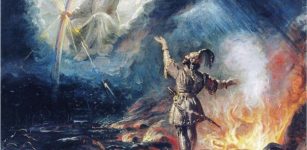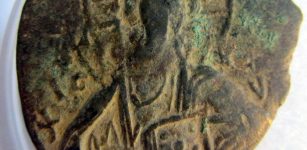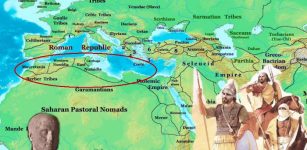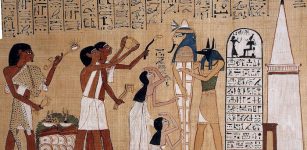Agni: Hindu God Of Divine Illumination And One Of The Three Supreme Deities Of Vedic Lore
A. Sutherland - AncientPages.com - Agni is the fire god, represented as red and two-faced (sometimes covered with butter), suggesting both his destructive and beneficent qualities and with black eyes and hair, three legs, and seven arms (rays).
Agni (right) with his son Skanda (Karttikeya), (dated to 1st-century AD.) Biswarup Ganguly - CC BY 3.0
Agni rides a ram or a chariot pulled by goats or, more rarely, parrots. Seven rays of light emanate from his body. One of his names is "Sapta jihva" (‘seven tongues'). He is worshipped under a triple form: fire on the earth, lightning, and the sun.
Agni, lord of the fire and power of heat and light, has its origin in Vedic lore and is one of the most important divinities in the Hindu pantheon.
It is said that in the Rig Veda, the earliest Sanskrit text, there are more hymns dedicated to Agni than to any other divinity. Agni is the demi-god ruling fire, (in Latin: ‘ignis’, which is the root of English, ignite).
Agni (also known as Agnideva), is sometimes considered to be the son of earth and sky and sometimes he is called the son of Angiras, a Vedic rishi (sage) of Hinduism and a teacher of divine knowledge, and also a messenger between men and gods.
In the system of five elements of nature, which is found in Vedas, there are Earth (bhumi), Water (jala), Air (Vayu), Space (aakash) and Fire (agni). Agni is the purest element since you can never try to contaminate Agni because when you touch Agni, he will turn you into ash.
Hindu priest performing Agni Pooja or Worship to Fire. Credit: Adobe Stock - korkorkusung
According to ancient Hindu beliefs, Agni dwelled in the two pieces of wood that could easily be transformed to fire when rubbed together. Therefore he represented a symbol of three powerful forces of nature – earthly fire, lightning, and sun.
Most popular among the fire gods, Agni was an important part of a home as the hearth fire, not only necessary for cooking food and heating water, but also served as the gathering place for the family.
He was considered a friend because his powers served people; he protected them, granted them wealth and length of life. Agni was called upon always to take the gods to the ritual place so that they can hear the praises of the chanters and their requests as well.
People have long celebrated the great god Agni (fire) during various festivals organized on a grand scale. One such beautiful festival of light is organized at Thiruvannamalai, Tamil Nadu.
However, Agni was not only associated with the hearth and earthly fire but also with sacrificial fire. It was later, he became much more as a purifier of sacrificial offerings rather than a fire god.
Agni on a ram. Credit: Public Domain
There is also yet another form of Agni, perhaps the most dangerous one. It is known as Vadavagni (literally Vadava-agni - “marefire”) and represents Agni’s most terrible form, which remains hidden deep under the sea. It’s waiting for the ‘right’ moment to destroy the world.
The Hindu scriptures mention an ancient belief that the escape of this fire from under the ocean which will, in the end, consume the current cycle of creation and prepare the universe for the next cycle of creation.
Later depictions of the god Agni show him in red or black color, with two faces, four hands, skin, which is red as fire flames, seven tongues for licking up the sacrificial butter, and a garland of fruit.
Another very interesting depiction of Agni shows him as Marut (immortal), one of the Hindu storm gods equipped with a flaming spear and riding in a chariot with wind instead of wheels and drawn with beautiful fiery horses.
Agni’s cult disappeared long ago but the ancient ceremonies associated with the fire still remain, keeping in mind the Hindu great deity – Agni, who grants immortality, purifies sinners after they died.
Also, participants of the funerals and wedding ceremonies never forget to call upon Agni.
Updated on June 21, 2021
Written by – A. Sutherland AncientPages.com Staff Writer
Copyright © AncientPages.com All rights reserved. This material may not be published, broadcast, rewritten or redistributed in whole or part without the express written permission of AncientPages.com
Expand for referencesMore From Ancient Pages
-
 On This Day In History: John Dee, English Mathematician, Occultist, Astrologer, Astronomer Was Born – On July 13, 1527
News | Jul 13, 2016
On This Day In History: John Dee, English Mathematician, Occultist, Astrologer, Astronomer Was Born – On July 13, 1527
News | Jul 13, 2016 -
 Evolution Might Stop Humans From Solving Climate Change – Researchers Say
Evolution | Jan 3, 2024
Evolution Might Stop Humans From Solving Climate Change – Researchers Say
Evolution | Jan 3, 2024 -
 The Red Dragon Of Wales – Ancient Symbol Dating Back To Roman Times
Ancient Symbols | Jan 3, 2018
The Red Dragon Of Wales – Ancient Symbol Dating Back To Roman Times
Ancient Symbols | Jan 3, 2018 -
 Secrets Of Neanderthals’ 130,000-Year-Old Carved Bear Bone Found In The Carpathian Mountains
Archaeology | May 24, 2024
Secrets Of Neanderthals’ 130,000-Year-Old Carved Bear Bone Found In The Carpathian Mountains
Archaeology | May 24, 2024 -
 Ukko: Karelian-Finnish God Of Thunderstorms, Harvest, Patron Of Crops And Cattle
Featured Stories | Apr 2, 2020
Ukko: Karelian-Finnish God Of Thunderstorms, Harvest, Patron Of Crops And Cattle
Featured Stories | Apr 2, 2020 -
 Race Against Time: Crucial Expedition To Delve Into Bouldnor Cliff, Europe’s Mesolithic Underwater Stone Age Site
Underwater Discoveries | Apr 28, 2024
Race Against Time: Crucial Expedition To Delve Into Bouldnor Cliff, Europe’s Mesolithic Underwater Stone Age Site
Underwater Discoveries | Apr 28, 2024 -
 Stone Homes Of Europe’s First Megalithic Builders Discovered
Archaeology | Feb 22, 2023
Stone Homes Of Europe’s First Megalithic Builders Discovered
Archaeology | Feb 22, 2023 -
 Secrets Of Ancient Skeletons Found In York – Who Were They And Where Did They Come From?
Archaeology | Jan 20, 2016
Secrets Of Ancient Skeletons Found In York – Who Were They And Where Did They Come From?
Archaeology | Jan 20, 2016 -
 Viking Cork Settlement Re-Writes Ancient History Of Ireland
Archaeology | Jan 16, 2018
Viking Cork Settlement Re-Writes Ancient History Of Ireland
Archaeology | Jan 16, 2018 -
 A 1,000-Year-Old Bronze Coin Accidentally Discovered By A Little Boy
Archaeology | Mar 12, 2020
A 1,000-Year-Old Bronze Coin Accidentally Discovered By A Little Boy
Archaeology | Mar 12, 2020 -
 ‘Giant’ Ant Fossil Raises Questions About Ancient Arctic Migrations
Fossils | Mar 8, 2023
‘Giant’ Ant Fossil Raises Questions About Ancient Arctic Migrations
Fossils | Mar 8, 2023 -
 New Genes May Explain Why Humans Got Such Big Brains
Archaeology | Jun 2, 2018
New Genes May Explain Why Humans Got Such Big Brains
Archaeology | Jun 2, 2018 -
 Dispute Between Russia And Poland Over Discovery Of Czarist Officer’s Corpse In Turkey
Archaeology | Apr 10, 2018
Dispute Between Russia And Poland Over Discovery Of Czarist Officer’s Corpse In Turkey
Archaeology | Apr 10, 2018 -
 Merkhet – An Ancient Egyptian Timekeeping Instrument
Ancient History Facts | Jul 3, 2018
Merkhet – An Ancient Egyptian Timekeeping Instrument
Ancient History Facts | Jul 3, 2018 -
 Rare Bes Mugs Reveal Ancient Egyptians Drank Hallucinogenic Cocktails During Rituals
Archaeology | Nov 18, 2024
Rare Bes Mugs Reveal Ancient Egyptians Drank Hallucinogenic Cocktails During Rituals
Archaeology | Nov 18, 2024 -
 On This Day In History: Emperor Gordian II Loses The Battle Of Carthage – On Apr 12, 238 AD
News | Apr 12, 2016
On This Day In History: Emperor Gordian II Loses The Battle Of Carthage – On Apr 12, 238 AD
News | Apr 12, 2016 -
 Evidence From Ancient Egypt Shows Smallpox Stretches Back At Least 3,000 Years
Archaeology | Jan 11, 2023
Evidence From Ancient Egypt Shows Smallpox Stretches Back At Least 3,000 Years
Archaeology | Jan 11, 2023 -
 Mysterious Runes Deciphered By School Children In Sweden Shed New Light On The Kensington Stone
Artifacts | Oct 4, 2019
Mysterious Runes Deciphered By School Children In Sweden Shed New Light On The Kensington Stone
Artifacts | Oct 4, 2019 -
 Vikings Brewed Beer With Heated Stones – Old Tradition Popular In Germany, Finland And Baltic States
Archaeology | Dec 14, 2017
Vikings Brewed Beer With Heated Stones – Old Tradition Popular In Germany, Finland And Baltic States
Archaeology | Dec 14, 2017 -
 Ancient DNA’s Analysis Delivers Crucial Clues To Migratory Patterns During The First Millennium AD
DNA | Jan 2, 2025
Ancient DNA’s Analysis Delivers Crucial Clues To Migratory Patterns During The First Millennium AD
DNA | Jan 2, 2025



